Friendship through art: a multimodal literacy and visual expression workshop for children
This article discusses the experiences of a six-day workshop themed on friendship. In this process, children explored stories, colors, and recycled art to express themselves. What began with hesitation blossomed into joy, empathy, and bold creativity—showing how art can build connection, confidence, and community.
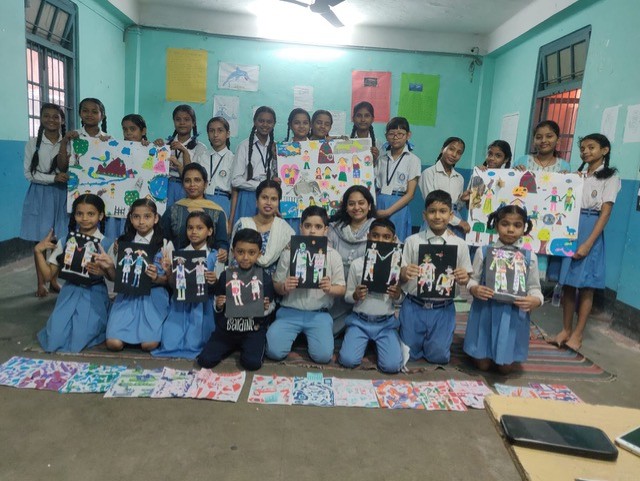
Photo credit: The Blue Ladder Trust
As we entered the school on the first morning of our visual art project, the air felt thick with anticipation. The narrow corridors echoed with distant voices, and the mosaic of children’s drawings on the walls seemed to watch us with silent curiosity. The small classroom was warm, and sunlight filtered through dusty windowpanes, casting golden rectangles on the floor. My team and I, hearts beating fast, were equal parts nervous and excited.
Stepping into the workshop
The space was modest, but the energy it held promised something magical. We had previously met the children, around twenty of them from grades 3 to 6, for a brainstorming session. Here, they unanimously chose ‘Friendship’ as the theme of our visual art experience. We felt that this topic was both heartening and essential to explore. Friendship, after all, is a cornerstone of social-emotional development. It is also a recurring motif in children’s literature and lived experiences.
The children arrived with bright eyes and louder voices than the corridors could hold. They seemed excited. None of them had a clue about what we were going to do in the workshop. All they knew was, they would have fun in it, just like they always had. This was vacation time and about 18 children had signed up for the workshop. Some had even postponed going back to their villages, just to attend the workshop, a fact that deeply moved us.
Their joy and commitment affirmed our belief in the work we do every day in the library and in school spaces. We introduced the five-day workshop as a space of exploration, imagination and connection. We shared how they were to have fun more than anything. We requested them to pour their hearts out. Our journey began with a playful grouping activity that filled the room with laughter and discovery. In their circles, children took turns sharing small but significant details about themselves—what they liked, what they feared, how they felt that day—a small act of community building that set the tone for deeper exchanges to come.
Stories of friendship
Then came the stories. The children were invited to pick from a carefully curated display of picture books, all centred on the theme of friendship. Along with stories on friendships, there were stories of unlikely companions—a crow and an elephant, a mountain and a bird—as well as more grounded tales of friends in schools, or children separated by war and migration.
As they read, we observed them smiling, like something had softened within them. Conversations began to emerge naturally—about loss, loyalty, kindness and what it means to be a good friend. These stories, rich in emotional resonance, helped the children place their own experiences within a broader human context.
As Feeney and Moravcik (2005) affirm, stories have tremendous power; they reach children’s hearts and minds. Stories enable them to understand themselves and the world in which they live. Their insights filled the blackboard. And we began constructing a vibrant word wall that would evolve throughout the week. This first day was our introduction to stories, the theme of friendship and a beginning to connect their experiences to books which would later be translated to a form of art.
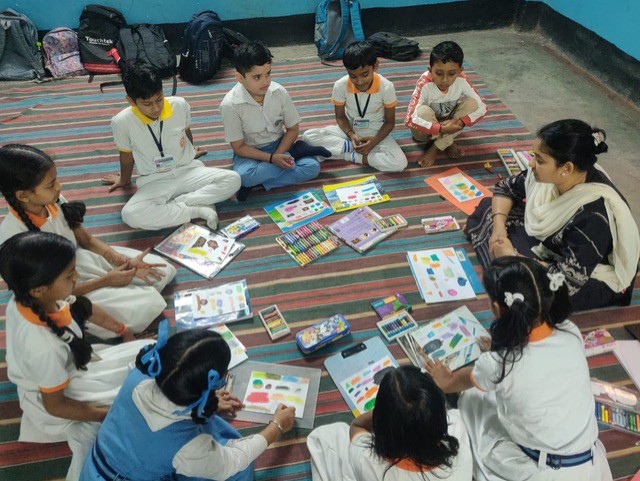
Photo credit: DAV High School, Guwahati
Exploring materials
The next day, with grades 3 and 4, we dove into oil pastel explorations. On white chart paper, the children played with color—mark-making, blending, scraping and layering. They were absorbed in the tactile experience, discovering how pressure and technique could change the visual effect and the several possibilities that oil pastels bring. Initially, many children worked in isolation, carefully guarding their papers as if to protect something personal. It became evident that they were accustomed to environments where comparison and competition were the norm—where individual achievement was valued over collective exploration.
When we invited them to observe and build on each other’s patterns, their surprise was obvious. Over the next few days, however, we witnessed a gentle shift. The idea that one could learn from a peer, rather than feel threatened by them, began to take root. This transformation—from working individually to co-creating a shared visual language—was as significant as the artworks themselves.
Meanwhile, grades 5 and 6 worked with recycled materials—cardboard, punch paper and newspapers. They tore, cut, rolled and moulded, gradually discovering the potential of these everyday items. At first, many were visibly hesitant. The invitation to manipulate paper freely was unfamiliar territory. They even asked if we were telling them that they could make a mess.
Their confusion and apprehension that surfaced was perhaps rooted in a deeply internalized belief that good paper must not be spoiled, and that art should look neat, tidy, and ‘correct’. This open-ended, process-based challenge—to express an abstract idea through tactile exploration, was certainly new. It took steady scaffolding and gentle encouragement to keep them going. It needed reminders for them that experimentation was welcome, that risk-taking was part of the creative journey.
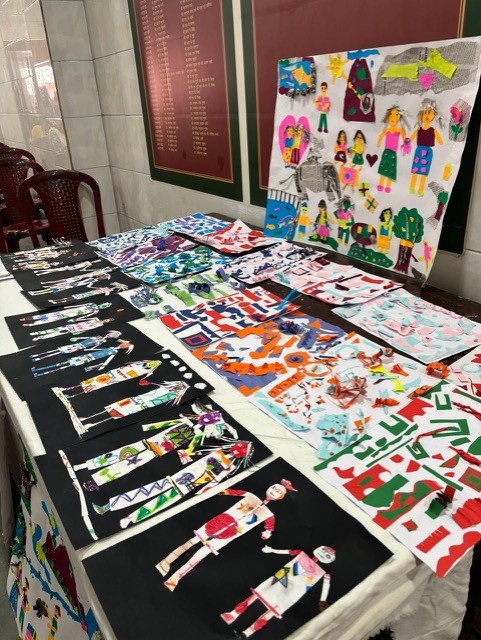
Photo credit: The Blue Ladder Trust
Grappling with collaborations
After the initial exploration, we began the next task, to create a collaborative chart to show an ideal school environment. They brainstormed ideas on how a school could be a space where every child could be happy. Each group put together a list of ideas. The next step was translating those ideas into form. Using the same materials and combining their material exploration ideas, each group had to create a chart showcasing their ideas. The task demanded imagination, collaboration and a willingness to break out of old patterns.
At first, there was hesitation. Faced with a blank sheet and some scattered ideas, the children paused—unsure how to begin, how to use their material explorations to communicate abstract thoughts and perhaps a little intimidated with the full-scape chart paper that they needed to cover. We offered gentle prompts, encouraging small group conversations and asking reflective questions. We dropped in some open-ended questions to reflect upon, gently scaffolding and nudging them to be brave and think some more.
Still, the process stalled. When movement on the artwork came to a standstill, we gathered everyone back into a circle and offered another demonstration. We showed, once more, how an idea could be put together. After this, back in the circles, there was some thinking, some tentative movement. However, the day ended with very little done on the chart sheets.
That evening, as a team, we felt an uncertainty settle in. This wasn’t the kind of workshop the children were used to. It was creatively demanding. Probably they hadn’t quite anticipated how much thinking, feeling and risking it would require. A flicker of anxiety surfaced. What if this didn’t move the way we had envisioned? What if the children couldn’t find a way to express their thoughts, and the chart sheets remained blank again? What if the creative challenge felt too intimidating, or they chose not to return the next day?
But instead of giving in to our doubts, we made a choice. We set our own inhibitions aside, chose to be optimistic and tweaked our plan. We decided to weave in some play, some fun activities to loosen the body and spirit before and after the artmaking.
Learning cooperation through artmaking
So, the next day as we waited for the children with crossed fingers, we breathed a sigh of relief when we saw them coming in. Only they weren’t as excited as they were when they had come in the previous day. They looked hesitant and unsure. We said, ‘All is well’ to ourselves and welcomed them with a reassuring smile and warm hugs.
We began by asking how the previous day went for them and invited them to speak freely. One child shared that the activity was harder than he expected. We were prepared for this and had already discussed it. A few of them asked if they could skip the chart work and do something different instead—maybe read a story or play a game. We smiled, recognizing their reluctance. We told them we were going to have fun and support them in a way that the task would feel easy. We shared that we would be creating a similar chart beside them and that we could all discuss with one another and freely share ideas.
We could sense their silent agreement. And then, we began with an exciting game and promised to end day with something just as thrilling. We gathered in a circle and each child was invited to voice and show some movement of a ferocious animal—a growling tiger, a hissing snake, a roaring bear. The room soon roared with laughter and sound. As children took bold turns performing, cheered on by their peers, they enjoyed. It was silly, it was loud, but it was liberating. This little activity set the tone and a happy mood to take up the chart work with renewed enthusiasm.
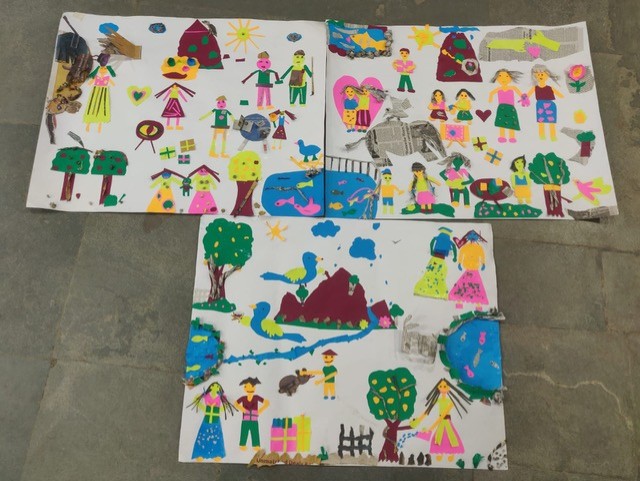
Photo credit: The Blue Ladder Trust
Back at their tables, we saw a new kind of energy. Something had shifted. Children were brainstorming ideas and trying new things. At first, they peppered us with questions, checking if they were thinking in the right direction. But when they noticed the facilitators immersed in their own chart—engaged, open, and genuinely curious about each group’s ideas—they began to take more creative risks. They also started collaborating more freely. We could feel the atmosphere, once hesitant, now pulsing with shared enthusiasm.
We dropped in open-ended questions to spark reflection and nudge their thinking in divergent directions, gently expanding the boundaries of what they thought was possible. As Nisha Nair, founder and executive director of the ArtSparks Foundation, notes in her book ArtSparks, “In classroom environments where learning is seen as a dynamic and attractive process, questioning techniques used appropriately encourage children to think as they formulate their own responses, ask questions of their own, recognize and embrace diverse points of view, and develop deep understanding. The art classroom provides a wonderful space within which such valuable learning can be promoted.” This moment resonated so much with the vision. From a place for making the room was now more a space for bold thinking, mutual respect and joy in discovery.
Soon, we could overhear lines that signalled a shift: “I got a wonderful idea from this group!” or “I’m making something similar to yours.” Children who had once guarded their artworks were now leaning in, looking over shoulders, asking questions, offering ideas. The notion that they were creating something unique and sharing ideas freely, seemed to free them.
Learning reflection as an artmaking tool
On the fourth day, with the younger group, we gathered in a large circle and read aloud another story of friendship. We encouraged children to reflect on their own friends—their appearance, their qualities, what they loved. We conducted a slowing down activity with a mindful walk across the hall, preparing for a focused drawing session. With quiet intent, we demonstrated how to sketch the human figure from memory and observation—no erasers allowed. The children carefully sketched portraits of their friends, capturing not just features but also thinking about their personalities and habits. We could see that they approached the challenge more bravely this time knowing that they would not be judged.
Once finished, they joyfully shared about their friends. Then, using the oil pastel exploration sheets from the earlier exploration, they created collages on the theme of ‘Me and my friend’. As they worked, they began to grasp the basics of size and proportion supported with careful facilitation and support from the team. For many in this group, it was their very first time making a collage. The initial form was ready by the end of the session. Now, they were to add more details.
With the older group, we read Mukand and Riaz, a story of two friends separated by partition. The children listened with quiet intensity. When asked about their own friendships, their responses brimmed with empathy. Some wondered aloud what life might feel like without their closest companions. We revisited the friendship word wall adding new words like longing, trust and loyalty. Inspired by the emotions stirred by the story, the children began a collaborative art challenge: to visually represent both the books they had read and the evolving vocabulary of friendship’s qualities and emotions.
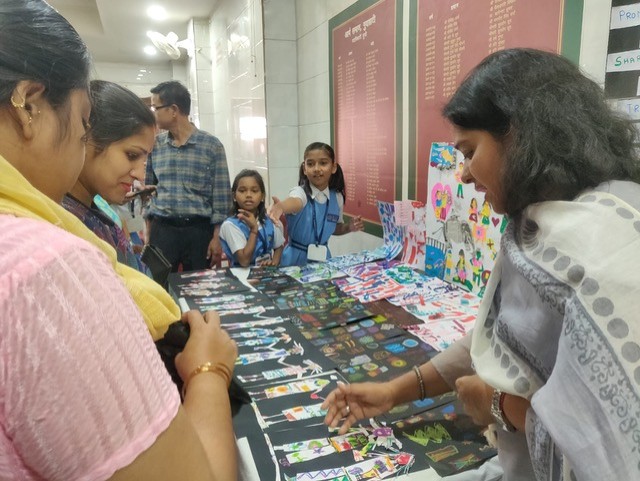
Photo credit: DAV High School, Guwahati
Using recycled materials, we created large art pieces representing the books we read on friendship earlier and some words from the word wall of friendship’s qualities and emotions. Each group first brainstormed ideas on paper and ideated, grappling with these questions. It was a challenging task: how does one illustrate something as abstract as loyalty or empathy? Yet as we scaffolded their process and made our own sample chart alongside them, the children’s confidence grew. We noticed that their confidence in approaching a challenging task had grown and creative risk-taking and trusting one another was beginning to catch on. This continued till the next day.
The groups were adding final details to their pieces—shading, layering, refining. With ideas flowing and encouragement from peers and facilitators alike, the artworks started coming together. By the end of the day, we were all spent—but joyfully so. The charts burst with color and ingenuity, echoing not only the stories they had read but the truths they carried within. The inventive use of recycled materials moved us—their choices were thoughtful, expressive and deeply personal. A quiet pride radiated from their faces as they took a step back and absorbed the finished pieces. The room was filled with anticipation for what came next: journaling and sharing these vibrant, deeply felt artworks with their families on the last day.
Sharing the process of collaborative artmaking
On the sixth day, we looked at our artworks. Their facial expressions revealed surprise and pride. “We didn’t know art could be like this,” one said. “I thought everything had to be perfect. But real things aren’t always perfect.” We used this moment to discuss how art imitates life: irregular, spontaneous, meaningful.
Then we invited the children to journal their experiences. And once again, we faced a familiar challenge: translating feelings into words. Though the week had stirred many new emotions—joy, pride, curiosity and the quiet warmth of being seen and heard, they struggled to articulate those emotions or translate those feelings into words. With the support of the facilitation team, sometimes guiding individuals one-on-one, we helped them craft short but sincere reflections, close to what they wanted to say.
On the final day, we prepared for an exhibition, and parents were invited. We started the day with a read aloud of the book ‘Stage fright’ written by Yamini Vijayan. The children were proud of their artworks. They were excited to show these to their parents but also nervous about speaking in public. One child also said that she felt faint with fear just like the character in the story.
We stood in a circle and held hands, with a promise to stay close and fill in whenever they wanted us to, as we were a team and this was a team effort. As the children prepared to share their artworks, they answered to three prompts: What did we make and why? How did it feel? What did we learn about ourselves or our friends? Our team gently supported them in articulating their thoughts, celebrating each voice and helping them craft their lines in simple words.
When parents arrived and it was time, we displayed all the art works. The children shared their creations and experiences. We stood beside them cheering like the friend in the story and reassuring that it was going great. Their parents were visibly moved. Some were teary-eyed, many grateful. Some were probably even wondering what kind of art this was but could not gather the courage to ask questions.
They told us, “We have never seen anything like this” or “It’s difficult for us to imagine my child made this.” In that moment, the small classroom became something larger. It was transformed into a space where stories, material and emotions were woven together into deep learning. As educators, we were reminded again of the quiet radicalism in giving children time, trust and the tools to explore their inner and outer worlds.
Conclusion
As we sat down to reflect on the week gone by—the moments of uncertainty, the breakthroughs, the laughter and the bold expressions—we found ourselves pausing to consider what it all meant. The experiences with the children offered insights that would gently shape our future work. As Paolo Freire said, “Reading the world always precedes reading the word” (Freire and Macedo, 1987). Our belief in the power of ‘reading the world’ and becoming literate through lived, sensory experiences was strengthened.
Each creative challenge, from making patterns inspired by everyday surroundings to borrowing and building upon each other’s ideas or translating rich memories into visual form, demonstrated that meaningful outcomes often arise from what we live and feel, not merely by what we read on paper. This was not just an act of teaching but an act of liberation.
References
Feeney, Stephanie, and Eva Moravcik. Children’s literature: a window to understanding self and others. YC Young Children 60, no. 5, 2005.
Freire, Paolo. Literacy: the importance of the act of reading. Routledge, 1983.
Nair, Nisha. Artsparks: ideas, methods, process. Tara Books, 2020.

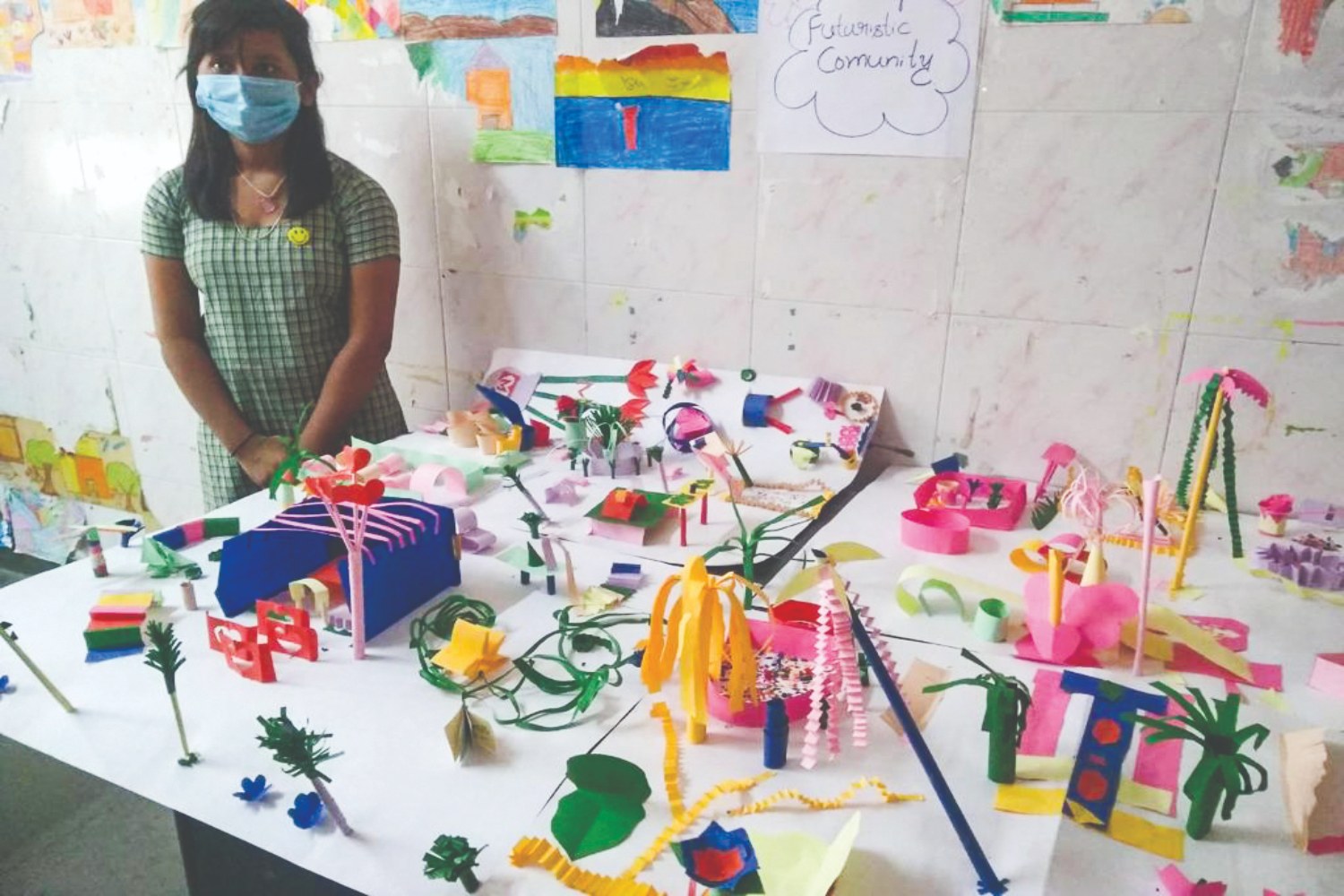
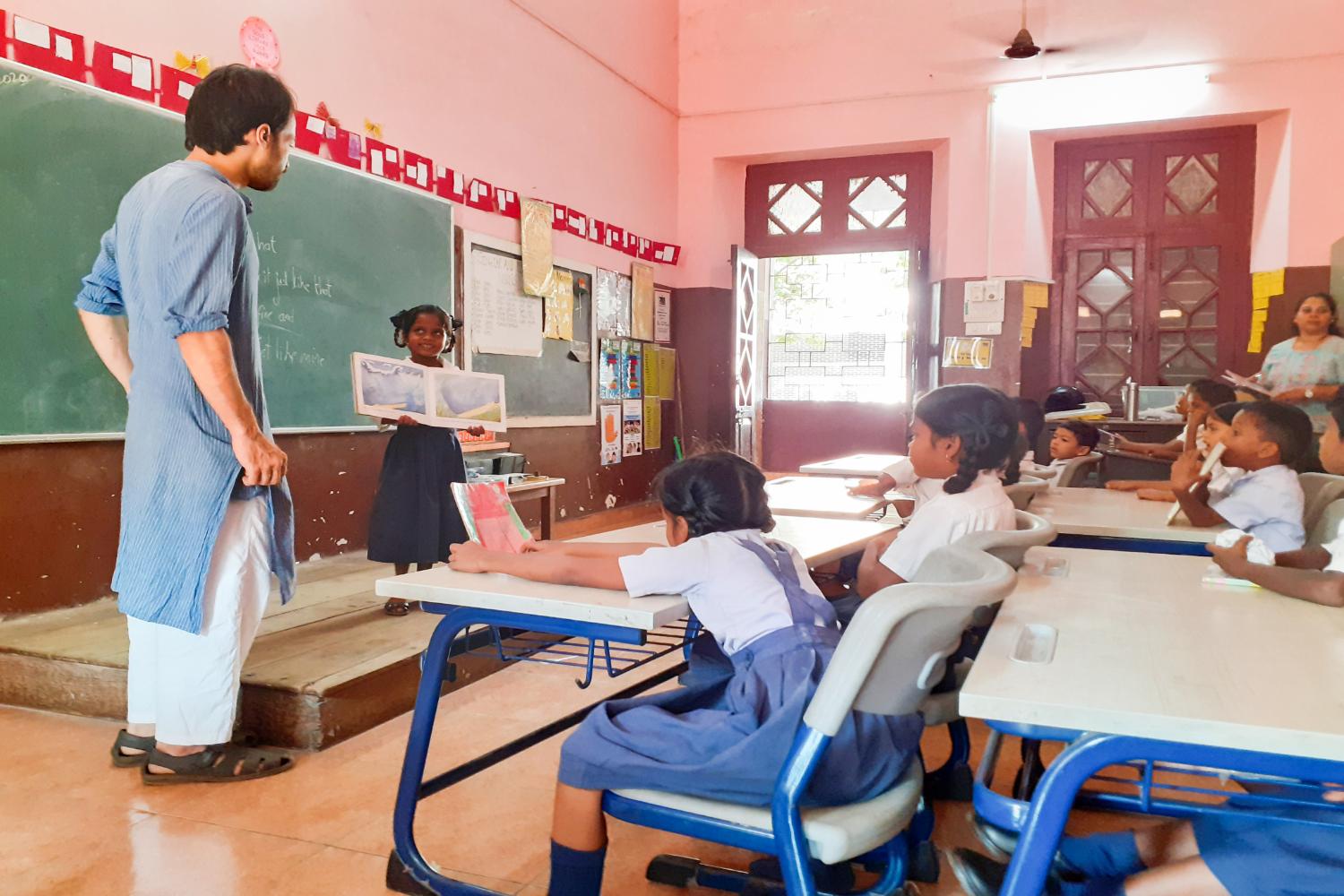
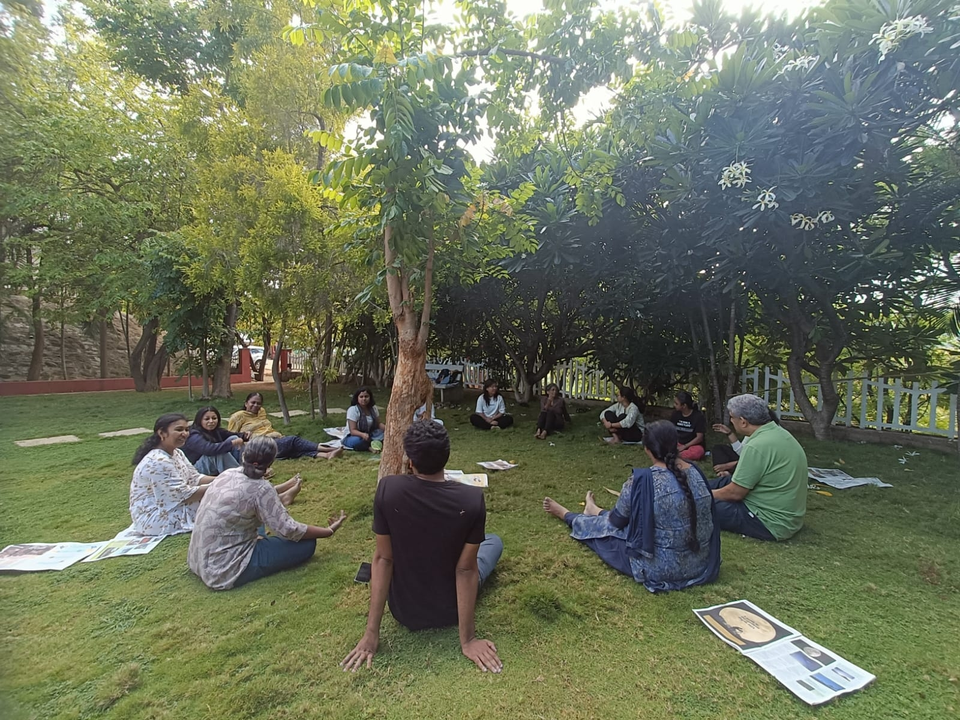
No approved comments yet. Be the first to comment!